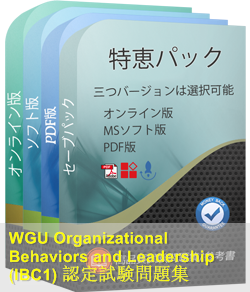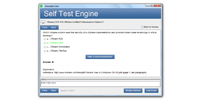ダウンロード可能なインタラクティブOrganizational-Behaviors-and-Leadershipテストエンジン
Courses and Certificatesの基礎準備資料問題集には、Courses and Certificates Organizational-Behaviors-and-Leadership試験を受けるために必要なすべての材料が含まれています。詳細は、正確で論理的なものを作成するために業界の経験を常に使用しているCourses and Certificates によって研究と構成されています。
あなたのOrganizational-Behaviors-and-Leadership試験合格を100%保証
JPNTestテスト問題集を初めて使用したときにCourses and Certificates Organizational-Behaviors-and-Leadership試験(WGU Organizational Behaviors and Leadership (IBC1))に合格されなかった場合は、購入料金を全額ご返金いたします。
Organizational-Behaviors-and-Leadership試験の品質と価値
JPNTestのCourses and Certificates Organizational-Behaviors-and-Leadership模擬試験問題集は、認定された対象分野の専門家と公開された作成者のみを使用して、最高の技術精度標準に沿って作成されています。
JPNTestでWGU Organizational-Behaviors-and-Leadership問題集をチョイスする理由
JPNTestは、1週間で完璧に認定試験を準備することができる、忙しい受験者に最適な問題集を提供しております。 Organizational-Behaviors-and-Leadershipの問題集は、WGUの専門家チームがベンダーの推奨する授業要綱を深く分析して作成されました。弊社のOrganizational-Behaviors-and-Leadership学習材料を一回のみ使用するだけで、WGU認証試験に合格することができます。
Organizational-Behaviors-and-LeadershipはWGUの重要な認証であり、あなたの専門スキルを試す認定でもあります。受験者は、試験を通じて自分の能力を証明したいと考えています。 JPNTest WGU Organizational Behaviors and Leadership (IBC1) は、Courses and Certificatesの80の問題と回答を収集して作成しました。WGU Organizational Behaviors and Leadership (IBC1)の知識ポイントをカバーし、候補者の能力を強化するように設計されています。 JPNTest Organizational-Behaviors-and-Leadership受験問題集を使用すると、WGU Organizational Behaviors and Leadership (IBC1)に簡単に合格し、WGU認定を取得して、WGUとしてのキャリアをさらに歩むことができます。
Organizational-Behaviors-and-Leadershipの迅速なアップデート対応
Organizational-Behaviors-and-Leadership試験に変更がございました場合は、現在の試験と一致するよう、瞬時に学習資料を更新することができます。弊社は、お客様に最高、最新のWGU Organizational-Behaviors-and-Leadership問題集を提供することに専念しています。なお、ご購入いただいた製品は365日間無料でアップデートされます。
WGU Organizational Behaviors and Leadership (IBC1) 認定 Organizational-Behaviors-and-Leadership 試験問題:
1. Which theory of motivation focuses on 5 levels of needs, and further separates those needs by lower-order needs and higher-order needs?
Choose 1 answer
A) Maslow's Hierarchy of Needs Theory
B) Two-Factor Theory
C) McClelland's Theory of Needs
D) McGregor's Theory X and Theory Y
2. What is one of the six primary characteristics that define an organization's culture?
A) Forecasting
B) Aggressiveness
C) Political orientation
D) People orientation
3. Which method should be used to maximize team member participation in global meetings?
Select one.
A) Change of global meeting membership frequently to maintain interest in meetings
B) Parallel voice messaging contacts to tie members together
C) A Delphi-like sequence of notes via carrier mail to share ideas and encourage dialog between members
D) Electronic technology to tie team members together during meetings
4. What is a characteristic of cross-functional teams?
Select one.
A) Although team members cross functions they come from the same work area.
B) Team members are from about the same hierarchical level.
C) Team members' votes on decisions are sequenced according to the hierarchy of the function they represent.
D) Team members are from a vertical cross-section of the organization.
5. Which dimension of the Fiedler contingency model is associated with the degrees of influence a leader has over variables such as hiring, firing, discipline, promotions, and salary increases?
A) Leader-member exchange
B) Leader-member relations
C) Task structure
D) Position power
質問と回答:
| 質問 # 1 正解: A | 質問 # 2 正解: D | 質問 # 3 正解: D | 質問 # 4 正解: B | 質問 # 5 正解: D |


 271 お客様のコメント
271 お客様のコメント





